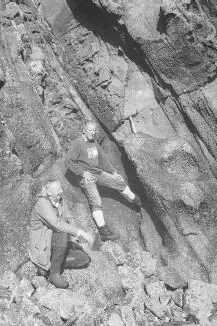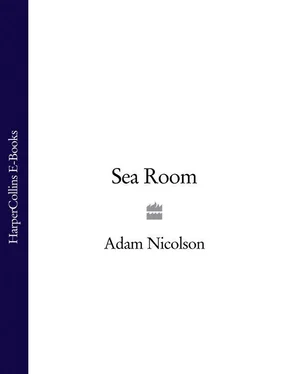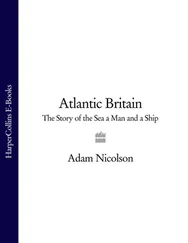In the Shiants, although the sandwich is 537 ft. thick, it is almost precisely like that, made up of four interleaved layers. The first, of a rock called teschenite, was 6 ft. thick (the top and bottom of this layer are now 531 ft. apart), the second (picrite), 78 ft. thick, the third (crinanite-picrodolerite), 440 ft. and the fourth (granular olivine picrodolerite), just 13 ft.

Beyond that, I fear, it becomes difficult for a layman to follow. I could tell you about the mineralogy of these islands, with the intriguing differences between picrite (which cooled slowly, so has big crystals and looks wormy, with an eroded surface like the mottled, liver-spotted skin of a toad or like penne in a pesto sauce) and picrodolerite (quicker cooling, a fine, granular porridge), or about the beauty in freshly broken rock of the tiny grape crystals of the olivine and the big black glitter of the pyroxenes, about the evolution of the magma over the years of its emplacement, so that the last spurts of it produce a strange, white, open-structured, vast-crystalled rock called syenite on Eilean Mhuire – but I won’t. This is not the place.
After the magma from the vast chambers below had finally exhausted itself, the Shiants, still deep underground, began to cool. From both above and below, the chill started to reach inwards into the heart of the semi-liquid mush, like the hemlock in the limbs of Socrates. It might have taken a century or so for the rock to become solid. As it cooled, it shrank, and that is the origin of the columns of which the Shiants are made. Any large body of shrinking material, contracting over its entire width, pulls apart from itself internally. Shrinkage cracks develop in the body of the rock identical to the network of polygons that develop on the floor of a drying lake. The columns are nothing more than a network of cracks extended into a third dimension.
If this cooling had been conducted in laboratory conditions, where the magma sheets were of equal thickness throughout and both upper and lower surfaces of the intrusions were level, then a structure of complete regularity would have emerged. All the columns would have been straight, the same size, and parallel. But this is not a laboratory. Some of the intrusions were clearly thin (in particular the one that formed the Galtas) and cooled more quickly. This has meant that the columns are themselves much thinner there. More intriguingly and beautifully, it is clear that the opening into which the magma squeezed was uneven. The columns would have formed by growing perpendicular to the cooling surfaces and here the unevenness of those surfaces has created columns that curve, twist and bend, are waved like the hair of art deco statuettes, fixed in the elegance of a geological perm, Jean Harlow turned to stone, Madonna having glimpsed the Gorgon.
Others, such as the upper sections of the north cliffs on Garbh Eilean, cooled so quickly that whole slaggy masses of rock became solid before columns could develop. Below them, deeply buried in the huge Garbh Eilean sill, the magma cooled very slowly indeed and here the Shiant rock-forms attain the great magnificence of the giant columns. These were the forms over which John Macculloch, the early geologist, enthused in 1819:
The lover of picturesque beauty will here, as in many other parts of the Western islands, be gratified with a display of maritime scenery combining the regularity of Staffa with the grander features of the coast of Sky. Towards the north it exhibits one continuous perpendicular face of naked rock. This face is columnar throughout, and forms a magnificent scene for the pencil; spreading in a gentle curve for a space of 1000 yards or more, and impending in one broad mass of shadow over the dark sea that washes its base. In simplicity and grandeur it exceeds Staffa almost as much as it does in magnitude; offering to the tourist an object as worthy of his pursuit as that celebrated island, and of no very difficult access from the northern extremity of Sky.
The Shiants languished in obscurity, while their more famous, and more accessible cousin-rocks off Mull became ever more visited. Perhaps the open waters of the Minch protect the Shiants from fame. Perhaps the nearness of Staffa to Iona creates its public success. And having witnessed, from the deck of a boat, Staffa sagging one summer’s day under the weight of its geological trippers, I can only say; ‘Thank God’.
A Gothic fate awaits the Shiants. There has been a steady geological drizzle over the millennia which has created the huge scree slopes at the feet of the cliffs. Giant pencil stubs the size of small houses lie tumbled like the aftermath of an earthquake. Sometimes, groups of them still hang together as if thrown in a clump on the rubbish heap. The birds live in many-storeyed tenements among them. If you walk across them, the lorry-sized rocks wobble and creak beneath you. Shiant dynamism is not over. The cliffs themselves are a symptom of the slices being taken out of them and the hard edges of the islands are signs of destruction in progress. ‘The upper millstone heaven,’ Ted Hughes once wrote, ‘Grinds the heather’s face hard and small.’ It isn’t only the heather. Fergus Gibb reckons that ‘a million years or two should see the Shiants off.’
Every spring, I look for the new scars, the beds from which the lumps of rock have broken away. They are unnerving places. Where the splits have occurred, the remaining edges are as sharp as knives. You can cut your hands on them. For some reason, the bare unlichened stone smells of iron or even blood, because blood smells of iron too. The smell is one of deep antiquity, a release into the nostrils of elements in the rock which have not been volatile since the rock was made. It feels as intimate as poking your fingers into a wound.
I have never witnessed something which I have spent hours in a boat waiting to occur: the collapse of an entire column from a cliff. Fergus has only seen it once, and then not here but in the similar rock formations in Trotternish, the northern wing of Skye, twelve miles or so to the south. He too was in a boat on the quiet sea. Alerted by a shuffling, a distant rumbling in the silence which on still summer days hangs around these places, Gibb looked up from his notes. Across the bay, an entire thin pencil, perhaps three hundred feet high, six or eight feet across, was slipping in slow motion into the sea. The base of the column, like many of them, must have been eaten away by the sea. Incredibly, the columns of which the islands are made are scarcely more bound to each other than pencils in a box and once the base has gone, knocked out by a winter storm, there is nothing to withstand the force of gravity. That morning, the column slid down, buckled and then fell, not like a felled trunk but with the shaft snapping in two places in mid-air before the three giant sections crashed like stone hail into the stillness of the Minch. The birds clattered away from the impact, the wash ran up to Gibb’s boat and on past it and the silence pooled back in. Fergus said it was like a glacier calving.
These rocks are killers too. In 1796 the Reverend Alexander Simson, the Minister of Lochs, described the Shiants in his statistical account of the parish:
There is one family residing on the largest of the islands. The head of this family has been so unfortunate as to lose, at different times, his wife, a son, and a daughter, by falling down great precipices; the mother and son met with this catastrophe in following sheep, and the daughter, by going in quest of wild-fowl eggs.
There is no further explanation of why they should have fallen. It is easy enough to slip on the dew-wet cliff-top grass, or to be blown away in a sudden gust, or for a rope to fail, but it seems likely enough to me that the collapse of part of a cliff might be to blame.
Читать дальше













